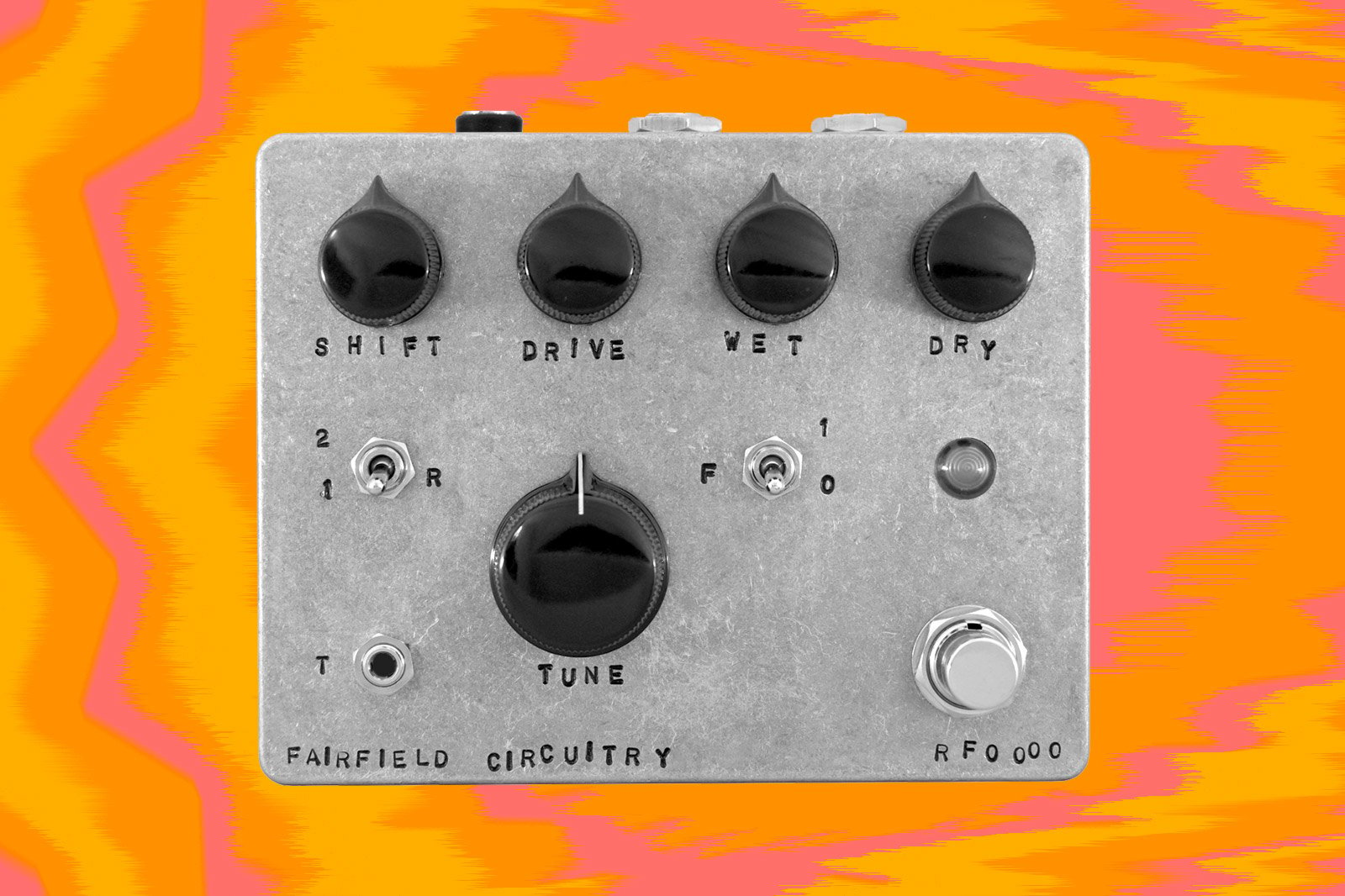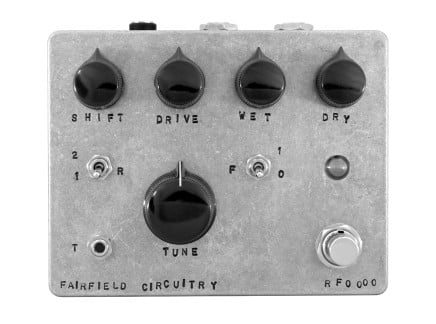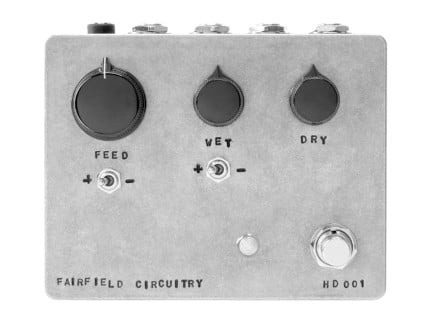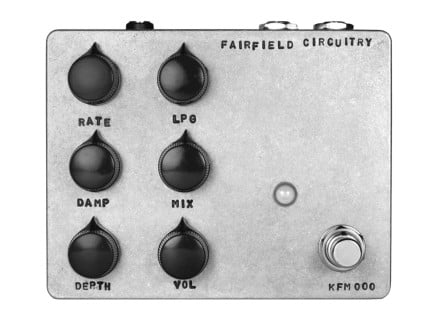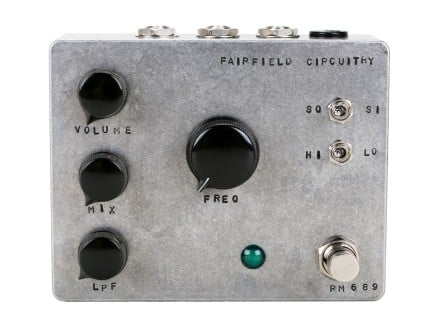Fairfield Circuitry's lineup contains a range of effects—from the utilitarian compression of Accountant to classic transparent overdrive tones of Barbershop. But they're also known for exploring some of the more peculiar outer reaches of analog effect pedal design: as in the gritty Randy's Revenge ring modulator, the ~900 and Unpleasant Surprise experimental fuzz pedals, the slippery, chorus/tape-warble-like Shallow Water, and the Hors D'oeuvres? active feedback loop pedal.
It has seemed that, as time has gone on, Fairfield has only become more adventurous, ambitious, and strange...so, it should come as no surprise that they've now introduced what may be their most unique and bizarre pedal to date: Roger That! Mimicking the behavior of failing radio transmitters and receivers, Roger That! is a novel approach to effect pedal design somewhere between a fuzz, distortion, waveshaper, and noise synthesizer. Have you ever just sat there with an analog radio, listening to all of the hiss, buzz, crackles, and noise blasts as you slooooowly tune between the stations? Well, Roger that is basically that sound in effect pedal format.
It's one thing to generate a "radio" effect through aggressive upper-mid-range EQing...Roger That! takes things much further. It emulates the actual process of FM signal modulation and demodulation, with its controls altering the encoded/decoded frequency and the accuracy with which the modulation/demodulation process tracks the source signal. What does that mean? Well, in short, you'll get a huge range of distinct sounds—all sorts of sputters, fizz, crackle, and extremely dynamic, touch-sensitive distortion textures unlike anything you've ever heard before. We love it, and we think it will sound great on everything from guitar and bass to synthesizers, drum machines, voice, winds...you name it.
In the remainder of this article, we're going to discuss Roger That!'s controls, offering some perspective on what they do and how you might use them—but frankly, it's a wild effect that you'll just have to play for yourself to fully understand.
Tuning In with Roger That!
Roger That! combines a great-sounding JFET overdrive, a fixed bandpass filter, a peculiar radio-like circuit, and a signal mixer to permit everything from solid-sounding distortion and EQ-like effects all the way to unrestrained sonic chaos. Check out the video below from our pal Sarah Belle Reid to get a sense of how Roger That! works...and then, let's take a look at the individual controls.
First things first: when your signal passes into Roger That!, it immediately hits a JFET preamp circuit with a variable front-panel drive control. It has enough gain to go from simple boost to gritty distortion, with plenty of shifts in tonal color in between. From there, you have two outgoing level controls: one for your dry signal, and one for your wet signal (the signal that passes through the "radio"-style circuitry). It's important to note a couple of things: 1) the dry signal and wet signal are both taken after the JFET preamp, and 2) the phase of the wet signal is inverted with respect to the dry signal. We'll talk a little bit more about what that means later.
Then we get into the especially fun and weird stuff: the Tune, R, and Shift controls. These controls are the center of Roger That!'s radio-like sonic character. The most profound of these is the Tune parameter, which you might conceptualize as being similar to an analog radio's tuning dial: as you turn it, you'll discover all sorts of bizarre artifacts and distinct sonic characteristics.
There are two main considerations worth unpacking here: first of all, turning the Tune knob can cause the pedal to create sound all by itself, without any external input. In fact, you could use it as a sound-generating device in its own right, producing hisses, sputters, squeals, and noise without the need for another instrument. Second, the response of the Tune knob is highly nonlinear. It's not like another fuzz, where turning the gain knob will linearly increase the amount of distortion you're hearing. Instead, turning the Tune knob really is more like tuning through different radio stations, all broadcasting the signal that you're sending to the input: each with their own bizarre destructions/deformations of the input signal. Some settings will seem like a super touch-sensitive synth-like fuzz; others will seem like thin, crackly, voltage-starved distortions; others will sound like slightly filtered overdrive tones; some will bear little resemblance to the input, more like an all-out destroyed Schumann PLL tone. It's hard to predict, and precise settings will be difficult to recreate—it's all about finding whatever crazy tones emerge in the moment of creation.
The Tune knob also offers a Range switch (R), which switches between "normal" and "extended" range. Generally speaking, the extended range has more fizzy high end and a somewhat wilder response to the Tune parameter...but there is plenty of bizarre stuff to discover in both ranges.
It's also worth noting that the Tune parameter has a front-panel 3.5mm control voltage input—making it possible to control Roger That! from CV sequencers, modular synthesizers, and more. The possiblities there are staggering, especially given that changes to the Tune parameter can cause Roger That! to create sound all on its own. You could send in a CV sequence to create a bizarre drum machine—heck, you could send an oscillator into the Tune input with nothing plugged into the audio input and treat it like a super messed-up waveshaper.
The Tune and Range controls work in tandem with the Shift control, which according to Fairfield "shifts the accuracy of tracking the incoming modulated signal." Often times, this parameter seems to act like a crude filter that gets darker as it is turned up...but it's a bit hard to pin down exactly what it does in standard audio effect terminology because...well...this isn't a standard audio effect. The response of Shift and Tune are highly dependent on one another, so much so that they sometimes seem to do the same thing. Between Tune, Range, and Shift, you're going to find infinite sonic variations—and once you really start to push the Drive control, you'll discover all sorts of downright odd, extreme, wacky, and aggressive sonic nonlinearities.
The final control is a switch labeled F, which activates a fixed-frequency bandpass filter with a pass band of 300Hz–3kHz. This is only applied to the wet signal, and it can make a huge difference in tone—somewhat mimicking the "telephone filter" EQ effect. Here, though, it's worth returning to the idea that the Dry and Wet signals are inverted. This means that, when the Filter is engaged, it's possible to create mid-scoop effects of variable intensity simply by finding the right balance between your dry and wet signals. In more extreme Tune/Shift/Range settings, this can also be used to emphasize or de-emphasize specific aspects of the "radio" effect. Again, the mind reels at all of the possibilities.
Communication Breakdown
From what we've heard so far, Roger That! is a stellar way of adding completely unique sonic grit to basically any sound source you want. It turns sterile bass into deep, snarling synth-like tones; it turns clean pads into distant, howling, crackling textures; it turns voice into aggressive screams and broken-up soundscapes. You can push the JFET pre to get to a variety of conventional distortion effects, but you can also explore the "radio" parameters to treat the pedal like an instrument in its own right.
We've been consistently impressed by Fairfield's inventiveness, and they've truly outdone themselves with Roger That!. It's not often that we see entirely new effect pedal concepts, but this is a glowing exception—one that rewards careful listening and an adventurous approach to sound design. We expect it'll find a home in the setups of many different types of musicians: guitarists and bassists looking for new sounds, modular synth performers in need of an aggressive sonic angle, sound designers seeking a dark cinematic edge to their compositions.
In short? If you like gnarly sounds and you want an effect that'll give you a completely new perspective on what your instrument can sound like, Roger That! will offer tons of new sonic territory and inspiration.

